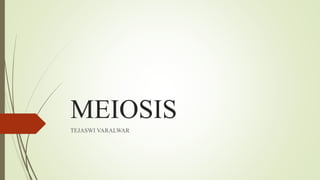
Meiosis
- 2. OVERVIEW Meiosis is a kind of cell division that leads to the production of gametes. gametes: egg cells and sperm cells contain half the number of chromosomes of an adult body cell Adult body cells (somatic cells) are diploid, containing 2 sets of chromosomes. Gametes are haploid, containing only 1 set of chromosomes.
- 3. OVERVIEW Sexual reproduction includes the fusion of gametes (fertilization) to produce a diploid zygote. Life cycles of sexually reproducing organisms involve the alternation of haploid and diploid stages. Some life cycles include longer diploid phases, some include longer haploid phases.
- 4. Spermatogenesis 2n=46 human sex cell diploid (2n) n=23 n=23 n=23 n=23 n=23 n=23 sperm haploid (n)
- 5. Meiosis – mouse testes
- 6. Features of Meiosis Meiosis includes two rounds of division – meiosis I and meiosis II. During meiosis I, homologous chromosomes (homologues) become closely associated with each other. This is synapsis. Proteins between the homologues hold them in a synaptonemal complex. 6
- 7. 7
- 8. Features of Meiosis Crossing over: genetic recombination between non-sister chromatids physical exchange of regions of the chromatids chiasmata: sites of crossing over The homologues are separated from each other in anaphase I. 8
- 9. Features of Meiosis Meiosis involves two successive cell divisions with no replication of genetic material between them. This results in a reduction of the chromosome number from diploid to haploid. 9
- 10. 10
- 11. Meiosis I (four phases) Cell division that reduces the chromosome number by one-half. four phases: a. prophase I b. metaphase I c. anaphase I d. telophase I
- 12. Prophase I Longest and most complex phase (90%). DNA condenses to form chromosomes. Duplicated chromatids are joint together at centromere Synapsis occurs: homologous chromosomes come together to form a tetrad and exchange chromosomal matter called recombination or crossing over Nuclear membrane begins to breakdown. Centrosomes migrate to opposite ends of the cell Microtubules appear and attach to chromosomes
- 13. Prophase I - Synapsis Homologous chromosomes sister chromatids sister chromatids Tetrad
- 14. Homologous Chromosomes Pair of chromosomes (maternal and paternal) that are similar in shape and size. Homologous pairs (tetrads) carry genes controlling the same inherited traits. Each locus (position of a gene) is in the same position on homologues. Humans have 23 pairs of homologous chromosomes. a. 22 pairs of autosomes b. 01 pair of sex chromosomes
- 15. Karyotype A method of organizing the chromosomes of a cell in relation to number, size, and type.
- 16. Homologous Chromosomes Paternal Maternal eye color locus eye color locus hair color locus hair color locus
- 17. Humans have 23 Sets of Homologous Chromosomes Each Homologous set is made up of 2 Homologues. Homologue Homologue
- 19. Metaphase I Shortest phase Tetrads align on the metaphase plate. INDEPENDENT ASSORTMENT OCCURS: 1. Orientation of homologous pair to poles is random. 2. Variation 3. Formula: 2n Example: 2n = 4 then n = 2 thus 22 = 4 combinations
- 20. Metaphase I terminal chiasmata hold homologues together following crossing over microtubules from opposite poles attach to each homologue, not each sister chromatid homologues are aligned at the metaphase plate side-by- side the orientation of each pair of homologues on the spindle is random
- 21. Metaphase I metaphase plate OR metaphase plate
- 22. Anaphase I Homologous chromosomes separate and move towards the poles. Sister chromatids remain attached at their centromeres. -microtubules of the spindle shorten
- 23. Anaphase I
- 24. Telophase I Each pole now has haploid set of chromosomes. nuclear envelopes form around each set of chromosomes sister chromatids are no longer identical because of crossing over Cytokinesis occurs and two haploid daughter cells are formed.
- 25. Telophase I
- 26. Meiosis II No interphase II (or very short - no more DNA replication) Meiosis II is similar to mitosis
- 27. Prophase II Again chromosomes condense Nuclear envelope dissolves and spindle apparatus form Difference between prophase 1 and 2 is that daughter cells have only one copy of each homologous chromosome. No synapses
- 28. Metaphase II Chromosomes align on the metaphase plate or the equator of the cell. Since chromatids are no longer identical, there will be many possible ways to align. metaphase platemetaphase plate
- 29. Anaphase II sister chromatids separate from each other as microtubules shorten
- 30. Telophase II Nuclear membrane reforms and cytoplasm is divided into two haploid daughter cells Nuclei form. Cytokinesis occurs. Four haploid daughter cells are produced gametes = sperm or egg
- 31. Telophase II
- 32. End Of Meiosis Meiosis II began with two cells and those further split into two cells each We now have 4 haploid cells at the end of meiosis These cells are gametes
- 33. Meiosis 2n=4 sex cell diploid (2n) n=2 n=2 meiosis I n=2 n=2 n=2 n=2 sperm haploid (n) meiosis II
- 34. END OF INTERPHASE PROPHASE I METAPHASE I ANAPHASE I MEIOSIS I Genetic recombination results from crossing over during prophase I of meiosis
- 35. TELOPHASE II ANAPHASE II METAPHASE IIPROPHASE IITELOPHASE I MEIOSIS
- 36. METAPHASE I METAPHASE I TELOPHASE II METAPHASE II INDEPENDENT ASSORTMENT
- 37. egg polar body spermatogonium primary spermatocyte secondary spermatocyte oogonium primary oocyte secondary oocyte polar bodies (will be degraded) spermatids meiosis ll meiosis l SPERMATOGENESIS OOGENESISa b
- 38. Meiosis vs Mitosis Meiosis produces haploid cells that are not identical to each other. Genetic differences in these cells arise from: -crossing over -random alignment of homologues in metaphase I (independent assortment) Mitosis produces 2 cells identical to each other. 38
- 39. 39
- 40. THANK YOU